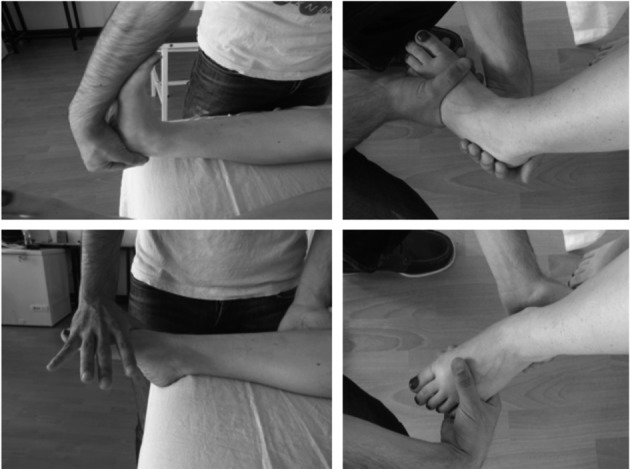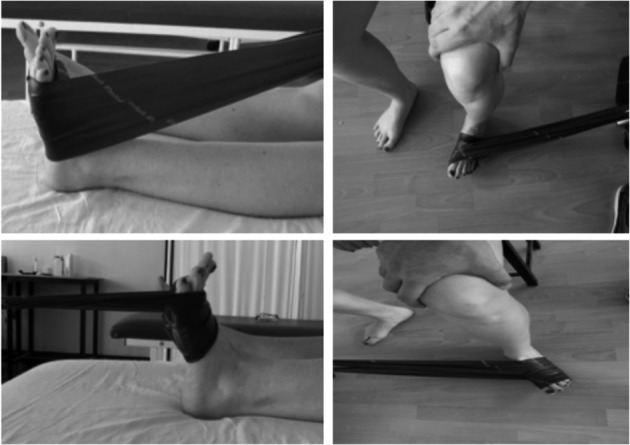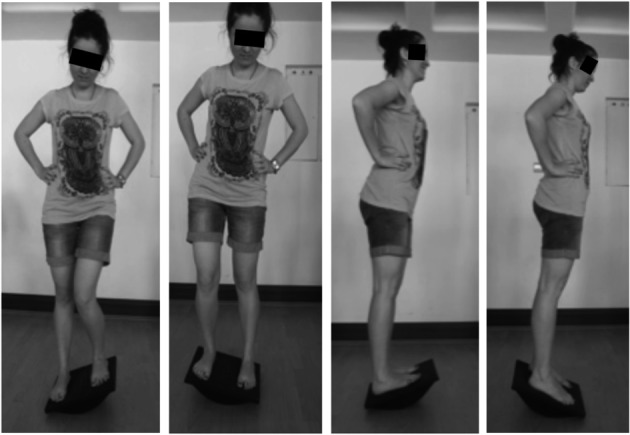Abstract
[Purpose] This study aimed to investigate the effect of ankle proprioceptive training on static body balance. [Subjects and Methods] In this randomized-controlled, single-blind study, 59 university students (35 females, 24 males) were randomized into study (n=29) and control (n=30) groups. The study group received a foot and ankle proprioceptive exercise program including stretching, strengthening (plantar and dorsi-flexors, invertor and evertor muscles), and balance board exercises, each with 10 repetitions per session, 5 days a week, for a total of 10 sessions. The control group did not receive any intervention. Static body balance was evaluated by a kinesthetic ability trainer, which showed the balance index scores under both single foot and both feet conditions. This evaluation was repeated at the end of two weeks for both groups. [Results] Outcome measures of the groups were similar at the baseline. Balance index scores of both groups improved at the end of two weeks, and the study group had significantly lower index scores than those of the control group, indicating better balance. [Conclusion] Ankle proprioceptive training had positive effects on static body balance parameters in healthy individuals, and it is worth investigating the effects of this type of training in patients with balance disorders.
Key words: Ankle proprioception, Static balance, Sport KAT
INTRODUCTION
The ankle joint is in close proximity to the body’s base of support, thus playing an integral role in maintaining balance. Stability of the ankle joint is paramount when considering regulation of balance1). Capsular and ligamentous structures, musculotendinous units, and the anatomical alignment of the osseous components are the stabilizing elements of the normal ankle2). The ability to maintain balance during standing on a single leg or both legs requires integrity of the visual, vestibular, and nervous systems. In the presence of an intact vestibular system, standing with eyes closed depends mostly on the normal function of the various proprioceptive receptors2). Proprioceptive information is generated by ligamentous mechanoreceptors, Golgi tendon organs, and muscle spindles, which transduce mechanical distortion of the surrounding connective tissue2). Stability of the ankle joint during functional activities depends on the presence of intact neural input from proprioceptors in the joint capsules, ligaments, muscles, tendons, and skin2).
Considering this knowledge, the findings of the related literature samples suggest that ankle proprioception is closely related to balance control and that balance is negatively affected by impaired ankle proprioception after injuries3). However, the results of studies investigating the effects of proprioceptive training on body balance, or vice versa, are conflicting4,5,6). Powers et al. investigated the effect of 6 weeks of strength and proprioception training on measures of muscle fatigue and static balance in subjects with unilateral functional ankle instability (FAI) and found that there were no significant effects of strength or proprioception training on these measures4). Rozzi et al. suggested that 4 weeks of balance training was effective in improving joint proprioception and single-leg standing ability in subjects with unstable and non-impaired ankles5). Chong et al. mentioned that healthy subjects reported improvements in balance control following a purported ankle proprioception training program, although their results revealed that a training program that controlled general balance did not specifically target ankle proprioception6).
Considering the above-mentioned knowledge about the close relationship between ankle proprioception and balance, and the conflicting results of the literature samples, the present study aimed to investigate the effect of ankle proprioceptive training on static body balance in healthy individuals.
SUBJECTS AND METHODS
This randomized-controlled, single-blind study was planned and performed as a graduation study for physiotherapy and rehabilitation students. Administrative permission was obtained from the Rectorate of Muğla Sıtkı Koçman University. The study sample was derived from students of the same university.
The inclusion criteria for the study were absence of musculoskeletal, neurologic, orthopedic, rheumatic or cardiopulmonary disease; lower extremity deformity; muscle weakness (<4/5 according to manual muscle testing); and postural impairment.
Among eligible candidates, 59 healthy university students (35 females, 24 males) with an age range of 18–28 years were included in the study, after signing informed consent forms, in accordance with the Declaration of Helsinki. Subjects were randomized into the study (n=29) and control (n=30) groups by drawing “study” or “control” cards from closed envelopes. All subjects received treatment or control conditions as allocated.
Sex (female/male), body mass (kg), height (m), and body mass index (kg/m2) values of the subjects were recorded as the physical characteristics. In addition, their dominant leg (right/left) and dominant foot length (cm) were recorded. A physiotherapist, blinded to the group of subjects, performed all assessments, including the static body balance test.
Static body balance was evaluated using a kinesthetic ability trainer (Sport KAT Model 650-TS, LLC, USA), which shows the balance index scores in both conditions: single foot and both feet. This device consists of a circular platform with varying degrees of stability, centered by a small pivot. In the preliminary session, the subjects were familiarized with the balance assessment system. The pound per square inch (PSI) level was adjusted to 6, and once comfortable on the testing device, the subjects performed a formal static test. They stood on the platform with their hands on opposite shoulders; they were then asked to stand in place, maintaining balance. The objective of the static balance test on this device was to maintain the platform at the initial level relative to the X- and Y-axes. Therefore, during the static balance test, the subjects kept their eyes open to view the monitor screen and tried to keep the “X” in the center of the screen. The printouts included a numerical score, based on the actual time spent on the exercise and the distance from the center of the platform, measured every second. The test was performed on both feet and on the dominant and non-dominant bare foot, each testing session lasting for 30 seconds. Balance index scores range from zero to 6,000, and the lower the score, the better is the balance index7). Static balance index score above 500 is considered a poor result8, 9).
After balance assessment, the study group received a foot and ankle proprioceptive exercise program composed of stretching (Fig. 1), strengthening by Theraband10) (Fig. 2), and balance board exercises (Fig. 3) consecutively, for plantar and dorsiflexors and invertor and evertor muscles, each with 10 repetitions per session, 5 days a week, for a total of 10 sessions. The control group did not receive any intervention. Balance index score evaluation was repeated at the end of 2 weeks for both groups.
Fig. 1.

Stretching exercises for dorsal and plantar flexors, invertors, and evertors
Fig. 2.

Strengthening exercises for dorsal and plantar flexors, invertors, and evertors
Fig. 3.

Balance board exercises
SPSS for Windows 20 was used for statistical analysis. The Kolmogorov-Smirnov test was used to test the normality of data distribution. Since normal distribution was observed, quantitative data were analyzed by independent t-test for inter-group comparisons, and by paired t-test for intra-group comparisons. Statistical significance level was set at p<0.05.
RESULTS
There were 17 (58.62%) females and 12 (41.38%) males in the study group, and 18 (60%) women and 12 (40%) men in the control group.
The groups were similar at the baseline in aspects of physical characteristics (p>0.05), except age, which was statistically higher in the control group (p<0.05) (Table 1). The dominant leg of five subjects was the left (one in the study group and four in the control group), whereas for the remaining, it was the right. The mean dominant foot length of the study and control groups was similar (39.83±2.05 cm and 39.77±2.84 cm, respectively; t=0.94, p=0.925).
Table 1. Physical characteristics of the groups.
| Study n=29 X±SD |
Control n=30 X±SD |
|
|---|---|---|
| Age (years)* | 21.1±1.8 | 22.1±1.9 |
| Body mass (kg) | 64.8±10.4 | 66.5±12.4 |
| Height (m) | 171.4±7.7 | 170.8±9.8 |
| Body mass index (kg/m2) | 21.9±2.3 | 22.7±2.8 |
* Statistically significant (p<0.05)
The outcome measures were also similar in both groups at the baseline evaluation (p>0.05) (Table 2).
Table 2. Inter-group comparisons of the pre-intervention and post-intervention balance index scores (BIS).
| Study Group n=29 X±SD |
Control Group n=30 X±SD |
||
|---|---|---|---|
| Double foot static BIS | Pre | 190.1±42.1 | 220.6±71.7 |
| Post* | 145.5±25.7 | 192.2±80.5 | |
| Dominant foot static BIS | Pre | 243.0±81.5 | 268.6±115.2 |
| Post* | 158.5±26.3 | 222.4±77.3 | |
| Non-dominant foot static BIS | Pre | 266.7±94.4 | 249.5±66.0 |
| Post* | 171.2±36.9 | 211.8±57.3 |
* Statistically significant (p<0.05)
At the end of two weeks, statistically significant improvements were found in the balance index scores of both groups (p<0.05) (Table 3), and mean balance index scores of the dominant and non-dominant foot and both feet were lower in the study group, indicating a higher improvement in balance scores (p<0.05) (Table 2).
Table 3. Intra-group comparisons of the pre-intervention and post-intervention balance index scores (BIS).
| Pre-intervention n=29 X±SD |
Post-intervention n=30 X±SD |
||
|---|---|---|---|
| Double foot static BIS | Study* | 190.1±42.1 | 145.5±25.7 |
| Control* | 220.6±71.7 | 192.2±80.5 | |
| Dominant foot static BIS | Study* | 243.0±81.5 | 158.5±26.3 |
| Control* | 268.6±115.2 | 222.4±77.3 | |
| Non-dominant foot static BIS | Study* | 266.7±94.4 | 171.2±36.9 |
| Control* | 249.5±66.0 | 211.8±57.3 |
* Statistically significant (p<0.05)
DISCUSSION
According to the results of this study, proprioceptive training for the ankle, including stretching, strengthening, and balance board exercises during two weeks, caused more significant improvements than no intervention in balance index scores in healthy individuals. The improvement of the balance index scores in the control group may be due to the learning effect related to the measurement technique.
Han, et al. have stated that ankle proprioception plays an essential role in balance control, since central processing of ankle proprioceptive information, along with other sensory information, enables integration for postural and balance control3). Hoffman and Payne investigated the effects of Biomechanical Ankle Platform System™ training on postural sway in healthy high-school students. Compared with subjects of the control group, those of the study group who received proprioceptive ankle disk training showed significant improvements in both the medial-lateral and anterior-posterior parameters of postural sway11). Mattacola and Lloyd investigated the effects of a six-week strength and proprioception training program on clinical measures of balance in subjects with previously sustained first-degree lateral ankle sprains. The results revealed that the strength and proprioception training program produced improvements in balance, as assessed dynamically on a single-plane balance board12). Arslan, et al. investigated the effect of an eight-week proprioception training program on dynamic postural control in taekwondo athletes, and concluded that this program improved dynamic postural control in taekwondo athletes13). Akre and Kumaresan compared the effectiveness of a four-week strengthening program and that of proprioceptive training on dynamic balance in athletes with chronic ankle instability, and found that both strengthening and proprioceptive training were equally effective in improving dynamic balance14). Lee and Lin investigated the effects of 12-week training with a biomechanical ankle platform system on postural stability and ankle proprioception in 12 university students with unilateral functional ankle instability, and showed that this training improved postural stability and ankle proprioception15).
The results of the present study, which are parallel to the findings of the related literature samples3, 11,12,13,14,15), showed that ankle proprioceptive training had positive effects on static body balance parameters in healthy individuals.
In the present study, the effect of an ankle and foot proprioceptive training program, which included strengthening, stretching, and balance board exercises, on static balance was assessed in healthy young subjects when their eyes were open. The rationale of this design was that static balance with open eyes is the easiest condition and the first step of more complex balance reactions. Positive outcomes of this type of training on the evaluated measures show that it is worth assessing the effects of this ankle proprioception training program in more complex conditions to maintain both static and dynamic balance, as well as in prevention and management of many diseases/impairments such as functional unstable feet, hypermobility syndromes, geriatric falls, or neurological problems with balance disorder.
REFERENCES
- 1.Blackburn T, Cuskiewicz KM, Petschauer MA, et al. : Balance and joint stability: the relative contributions of proprioception and muscular strength. J Sport Rehabil, 2000, 9: 315–328. [Google Scholar]
- 2.Isakov E, Mizrahi J: Is balance impaired by recurrent sprained ankle? Br J Sports Med, 1997, 31: 65–67. [DOI] [PMC free article] [PubMed] [Google Scholar]
- 3.Han J, Anson J, Waddington G, et al. : The role of ankle proprioception for balance control in relation to sports performance and injury. BioMed Res Int, 2015, Article ID 842804: 1–8. [DOI] [PMC free article] [PubMed] [Google Scholar]
- 4.Powers ME, Buckley BD, Kaminski TW, et al. : Six weeks of strength and proprioception training does not affect muscle fatigue and static balance in functional ankle instability. J Sport Rehabil, 2004, 13: 201–227. [Google Scholar]
- 5.Rozzi SL, Lephart SM, Sterner R, et al. : Balance training for persons with functionally unstable ankles. J Orthop Sports Phys Ther, 1999, 29: 478–486. [DOI] [PubMed] [Google Scholar]
- 6.Chong RK, Ambrose A, Carzoli J, et al. : Source of improvement in balance control after a training program for ankle proprioception. Percept Mot Skills, 2001, 92: 265–272. [DOI] [PubMed] [Google Scholar]
- 7.Kocak FU, Ulkar B, Özkan F: Effect of proprioceptive rehabilitation on postural control following anterior cruciate ligament reconstruction. J Phys Ther Sci, 2010, 22: 195–202. [Google Scholar]
- 8.Vrbanić TS, Ravlić-Gulan J, Gulan G, et al. : Balance index score as a predictive factor for lower sports results or anterior cruciate ligament knee injuries in Croatian female athletes—preliminary study. Coll Antropol, 2007, 31: 253–258. [PubMed] [Google Scholar]
- 9.Çetin N, Bayramoğlu M, Aytar A, et al. : Effects of lower-extremity and trunk muscle fatigue on balance. TOSMJ, 2008, 2: 16–22. [Google Scholar]
- 10.Kim KJ, Kim YE, Jun HJ, et al. : Which treatment is more effective for functional ankle instability: strengthening or combined muscle strengthening and proprioceptive exercises? J Phys Ther Sci, 2014, 26: 385–388. [DOI] [PMC free article] [PubMed] [Google Scholar]
- 11.Hoffman M, Payne VG: The effects of proprioceptive ankle disk training on healthy subjects. J Orthop Sports Phys Ther, 1995, 21: 90–93. [DOI] [PubMed] [Google Scholar]
- 12.Mattacola CG, Lloyd JW: Effects of a 6-week strength and proprioception training program on measures of dynamic balance: a single-case design. J Athl Train, 1997, 32: 127–135. [PMC free article] [PubMed] [Google Scholar]
- 13.Arslan F, Kaya M, Baltacı G, et al. : The effect of eight-week proprioception training program on dynamic postural control in taekwondo athletes. Ovidius Univ Ann Ser Phys Educ Sport Sci Mov Health, 2010, 10: 93–99. [Google Scholar]
- 14.Akre A, Kumaresan K: Comparison of a strengthening programme to a proprioceptive training in improving dynamic balance in athletes with chronic ankle instability (CAI). IOSR J Sports Phys Educ, 2014, 1: 18–20. [Google Scholar]
- 15.Lee AJ, Lin WH: Twelve-week biomechanical ankle platform system training on postural stability and ankle proprioception in subjects with unilateral functional ankle instability. Clin Biomech (Bristol, Avon), 2008, 23: 1065–1072. [DOI] [PubMed] [Google Scholar]


